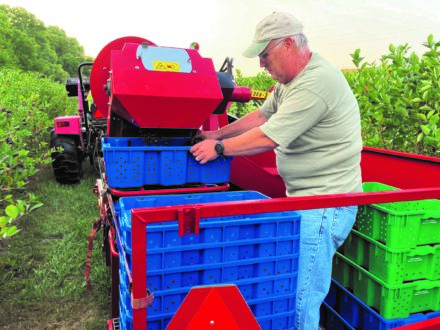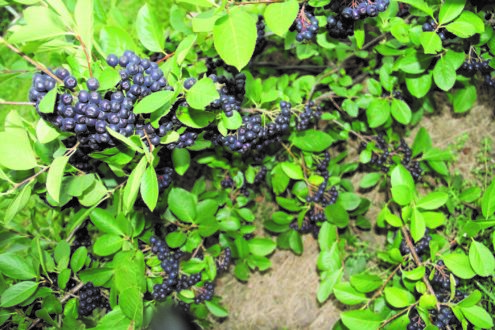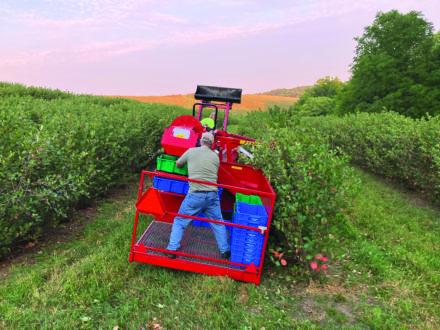

Feb 13, 2023Midwest grain growers add aronia berries
Some Midwest grain growers are diversifying their crops by adding a different type of berry.
Aronia berries, also known as chokeberries, grow on a deciduous woody shrub native to the eastern U.S.


In the U.S., approximately 200,000 aronia berry bushes are planted on an estimated 1,100 acres. Plantings are considered a more accurate measurement than acres, because the number of plants can vary by grower. Plants per-acre can range from 700 to 1,000.
Most commercial aronias are grown in the Midwest, primarily in Iowa, Nebraska, South Dakota, Wisconsin and Missouri. Iowa has the most growers, though the American Aronia Berry Association’s membership also includes growers in North Dakota, Minnesota, Illinois, Michigan, New York, Mississippi and California.
Aronia berries are hardy and easy to grow. Because they require a period of cold temperatures for dormancy, they do not do well in the Deep South, said Dean DuVal, a retired scientist with an Iowa State University analytical chemistry doctorate, who grows aronias near Castana, Iowa, southeast of Sioux City.
“They also represent a perennial crop that you can simply cut off at ground level every eight to 10 years, and they come back quickly and are producing berries again within three to four years,” he said. “Further, they do not grow well in low-lying areas where the roots stay wet. They are quite cold-hearty, growing well in North Dakota, Canada, Poland, and Russia with no problems.”
Program crop addition
Dale Hilgenkamp, an Arlington, Nebraska, corn and soybean grower northwest of Omaha, is the association’s president. He heard about aronias from other growers. Hilgenkamp’s brother planted a few acres of grapes near their father’s place.
“It looked like aronias had some good profit potential and was a way to diversify, to spread your labor a bit better throughout the year,” Dale Hilgencamp said. “That’s how we got started.”
Aronias bloom later than apples, pears and cherries, so they’re less susceptible to late-season freezes, said DuVal, who worked 32 years in consumer products for Procter & Gamble. In northwest Iowa, growing degree days should be between 2,700 and 2,900, he said.
“From a grower viewpoint, they complement other berry crops in terms of seasons as well as traditional row crops,” DuVal said. “The nice part about this is that this season fits in just before other small fruit, such as cranberries and apples. It’s kind of an off-season crop.”
In Iowa and Nebraska, aronias harvest during the last week of August and the first week of September, before the region’s growers begin harvesting corn and soybeans. After growers finish fertilizing and spraying row crops in the summer, they generally gain more time to devote to aronias, so the fruit fits in well with their other crops.


“Aronias work well with any producer, but particularly smaller farmers, as they don’t take a lot of acres to grow,” Hilgenkamp said.
The berries are relatively pest and disease free, Hilgenkamp said. During the first seven years of production, he didn’t experience much pest problems until Japanese beetles appeared, but pest pressure can vary. Unlike winegrapes, which are highly sensitive to spray drift from grain crops, the herbicides and pesticides don’t appear to bother the aronias.
Japanese beetles are DuVal’s primary pest.
“Other growers do not appear to have that problem,” he said. “It’s really a localized issue. I’m not aware of any disease problem in the U.S. The plant is quite hardy.”
Soil adaptability
Adaptable to a wide range of soil types, aronias prefer slightly acidic and moist soils, but appear to do well in dry areas. Hilgenkamp grows on silty clay loam soils.
“You don’t really want a lot of heavy clay or too sandy, either,” Hilgenkamp said.
An overabundance of clay can restrict plant growth.
“They grow well in any odd-shaped ground you may have,” he said. Some growers do foliar fertilizing in June to help with fruit production, DuVal said.
When DuVal first started growing aronias, grass was his biggest weed problem, and is a bigger challenge in growing organically, he said. DuVal adopted an on-label grass killer, Clethodim, to control his grass problem. In recent years in western Iowa, neem oil can partially control Japanese beetles. However, after using neem for several years, DuVal switched to Sevin in 2021. He said he found Sevin to be much more effective on Japanese beetles. It’s also one of the few insecticides on-label for aronias.
Because nitrogen creates heavy vegetative growth, which requires quicker pruning, Hilgenkamp stresses not applying too much of the fumigant. He applies foliar fertilizations and every couple of years, spreads over the rows a mix of dry chicken litter with humic acid to increase soil nutrients. Chicken litter decomposes slowly, so the plants avoid receiving a big flush of growth.
After a decade, aronia production starts to decline and canes grow too large to effectively bend and harvest with a side row harvester. A grower could hand prune the larger canes so the entire bush isn’t removed from production, DuVal said.
However, that requires much manual labor that isn’t cost-effective. A forestry mulcher can be used. The key is using something that provides clean cuts to the bush. A bush-hog is not recommended as the cuts are not clean, DuVal said.
It is also important to regularly trim bushes to maintain height between six and eight feet.
“Taller bushes simply cannot go through a side row harvester,” DuVal said. “A sickle cutter like those used in the vineyard business would work for both top and side trimming bushes to keep them at an optimum width and height.”
A large obstacle for smaller growers is expensive harvesting equipment. Few custom harvesters are available and may not be able to harvest at the optimum time, Hilgenkamp said. He and his brothers pooled resources to purchase a harvester from Poland developed specifically to harvest aronias. DuVal and Hilgenkamp also advise those considering growing aronias to start small and learn from others before investing a lot of money.
— Doug Ohlemeier, assistant editor
Top photo: Dean DuVal grows aronia berries in Iowa. He runs the harvester and switches out totes when filled with fruit. Photos: Dean DuVal














